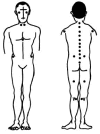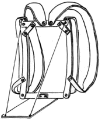Postural effects of symmetrical and asymmetrical loads on the spines of schoolchildren
- PMID: 17620121
- PMCID: PMC1971247
- DOI: 10.1186/1748-7161-2-8
Postural effects of symmetrical and asymmetrical loads on the spines of schoolchildren
Abstract
The school backpack constitutes a daily load for schoolchildren: we set out to analyse the postural effects of this load, considering trunk rotation, shoulder asymmetry, thoracic kyphosis, lumbar lordosis, and sagittal and frontal decompensation from the plumbline. A group of 43 subjects (mean age = 12.5 +/- 0.5 years) were considered: average backpack loads and average time spent getting to/from home/school (7 min) had been determined in a previous study conducted on this population. Children were evaluated by means of an optoelectronic device in different conditions corresponding to their usual everyday school backpack activities: without load; bearing 12 (week maximum) and 8 (week average) kg symmetrical loads; bearing an 8 kg asymmetrical load; after fatigue due to backpack carrying (a 7-minute treadmill walking session bearing an 8 kg symmetrical load). Both types of load induce changes in posture: the symmetrical one in the sagittal plane, without statistical significant differences between 8 and 12 kg, and the asymmetrical one in all anatomical planes. Usual fatigue accentuates sagittal effects, but recovery of all parameters (except lumbar lordosis) follows removal of the load. The backpack load effect on schoolchildren posture should be more carefully evaluated in the future, even if we must bear in mind that laws protect workers to carry heavy loads but not children, and results in the literature support the hypothesis that back pain in youngsters is correlated with back pain in adulthood.
Figures
Similar articles
-
Effect of asymmetrical backpack load on spinal curvature in school children.Work. 2015 Jun 5;51(2):383-8. doi: 10.3233/WOR-141981. Work. 2015. PMID: 25425595
-
Backpacks on! Schoolchildren's perceptions of load, associations with back pain and factors determining the load.Spine (Phila Pa 1976). 2002 Jan 15;27(2):187-95. doi: 10.1097/00007632-200201150-00014. Spine (Phila Pa 1976). 2002. PMID: 11805666
-
Postural compensations and subjective complaints due to backpack loads and wear time in schoolchildren.Pediatr Phys Ther. 2013 Spring;25(1):15-24. doi: 10.1097/PEP.0b013e31827ab2f7. Pediatr Phys Ther. 2013. PMID: 23288001
-
Effects of School Backpacks on Spine Biomechanics During Daily Activities: A Narrative Review of Literature.Hum Factors. 2020 Sep;62(6):909-918. doi: 10.1177/0018720819858792. Epub 2019 Jul 12. Hum Factors. 2020. PMID: 31298940 Review.
-
[Backpack and spinal disease: myth or reality?].Rev Chir Orthop Reparatrice Appar Mot. 2004 May;90(3):207-14. doi: 10.1016/s0035-1040(04)70096-3. Rev Chir Orthop Reparatrice Appar Mot. 2004. PMID: 15211269 Review. French.
Cited by
-
The impact of a school backpack's weight, which is carried on the back of a 7-year-old students of both sexes, on the features of body posture in the frontal plane.BMC Sports Sci Med Rehabil. 2022 Apr 2;14(1):57. doi: 10.1186/s13102-022-00448-8. BMC Sports Sci Med Rehabil. 2022. PMID: 35366944 Free PMC article.
-
Physical strain while wearing personal radiation protection systems in interventional radiology.PLoS One. 2022 Jul 21;17(7):e0271664. doi: 10.1371/journal.pone.0271664. eCollection 2022. PLoS One. 2022. PMID: 35862403 Free PMC article.
-
The Changes of Electromyography in the Upper Trapezius and Supraspinatus of Women College Students According to the Method of Bag-carrying and Weight.J Phys Ther Sci. 2013 Sep;25(9):1129-31. doi: 10.1589/jpts.25.1129. Epub 2013 Oct 20. J Phys Ther Sci. 2013. PMID: 24259929 Free PMC article.
-
Annual Observation of Changes in the Angle of Trunk Rotation. Trunk Asymmetry Predictors. A Study from a Scoliosis Screening in School Adolescents.Int J Environ Res Public Health. 2020 Mar 14;17(6):1899. doi: 10.3390/ijerph17061899. Int J Environ Res Public Health. 2020. PMID: 32183373 Free PMC article.
-
Chronic Effects of Asymmetric and Symmetric Sport Load in Varsity Athletes across a Six Month Sport Season.Int J Environ Res Public Health. 2023 Jan 25;20(3):2186. doi: 10.3390/ijerph20032186. Int J Environ Res Public Health. 2023. PMID: 36767552 Free PMC article.
References
LinkOut - more resources
Full Text Sources



